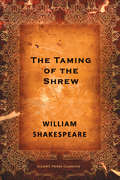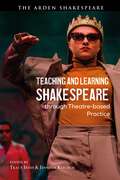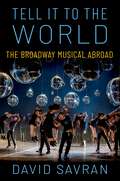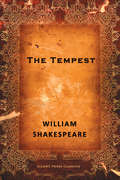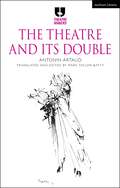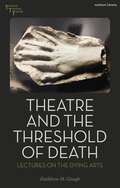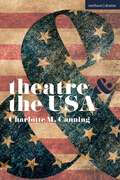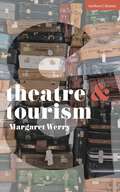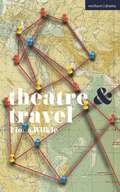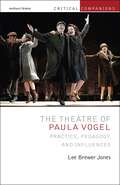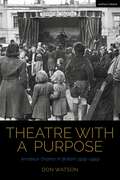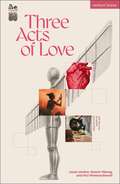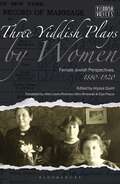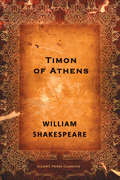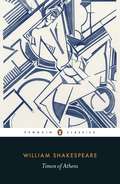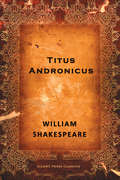- Table View
- List View
The Taming of the Shrew
by William ShakespeareThe marriage hopes of the beautiful Bianca depend on her older and more disagreeable sister, Katherina, making her match first.
The Taming of the Shrew
by William ShakespeareShakespearean comedy in which a woman rebels against the man she is forced to marry.
Taming of the Shrew (Skillan)
by George Skillan William ShakespeareFrench's Acting Edition of Shakespeare's Classic Play
Tartuffe or the Hypocrite
by Molière Curtis Hidden PageTartuffe a "man of God" uses his connections to swindle his generous host Orgon out of his wealth and his wife. [This text is listed as an example that meets Common Core Standards in English language arts in grades 11-12 at http://www.corestandards.org.]
Teaching and Learning Shakespeare through Theatre-based Practice
How can the study of Shakespeare contribute to equipping young people for the challenges of an uncertain future? This book argues for the necessity of a Shakespeare education that: finds meaning in the texts through inviting in the prior knowledge, experiences and ideas of students; combines intellectual, social and emotional learning; and develops a critical perspective on what a cultural inheritance is all about. It offers a comprehensive exploration of the educational principles underpinning theatre-based practice and explains how and why this practice can open up the possibilities of Shakespeare study in the classroom. It empowers Shakespeare educators working with young people aged 5-18 to interact critically, creatively and collaboratively with Shakespeare as a living artist.Drawing on the authors' research and experience with organizations including the Royal Shakespeare Company, Shakespeare's Globe, the Folger and Coram Shakespeare Schools Foundation, Part One consolidates recent developments in the field and engages in lively dialogue with core questions of Shakespeare's place in the classroom. Part Two curates a series of interviews with leaders and practitioners from the above and other Shakespeare institutions, exploring their core principles and practices. Part Three presents chapters from and about classroom teachers, who share their experiences of successfully embedding theatre-based approaches to Shakespeare in their own diverse contexts.
Tell it to the World: The Broadway Musical Abroad
by David SavranWhat happens when Broadway goes abroad? Tell It to the World: The Broadway Musical Abroad offers a look at how the Broadway musical travels the world, influencing and even transforming local practices and traditions. It traces especially how the musical has been indigenized in South Korea and Germany, the commercial centers for Broadway musicals in East Asia and continental Europe. Both countries were occupied after World War II by the United States, which disseminated U.S. American popular music, jazz, movies, and musical theatre in the belief that these nations needed to rebuild their cultures in accordance with U.S. guidelines. By the 1990s, Broadway imports had become phenomenally popular in Seoul and Hamburg while home-grown musicals proliferated that adapted and transformed the prototypes that had been disseminated by the U.S. Although this book focuses on recent musicals, it also looks back through the twentieth century to plot the evolution of musical theatre in South Korea and Germany. Part One considers the key questions: What is a musical? Why is it the great success story of U.S. theatre? How has it been assimilated to musical theatre traditions around the world? Part Two focuses on musical theatre in South Korea, studying the import/export business in large-scale musicals about Korean history and innovative hybrid experiments that mix local performance traditions with the Broadway vernacular. Part Three moves to Europe to analyze the conflicted attitudes toward musicals in the German-speaking world. Its three chapters survey the history of musicals in Germany from 1945 until the fall of the Berlin Wall, the reconfiguration of musical theatre conventions by experimental directors, and finally the ground-breaking German-language productions of Broadway classics by Barrie Kosky and other innovative directors. In the twenty-first century, Broadway-style musical theatre has succeeded in becoming a lingua franca, the template for musical theatre around the world. This book shows how some of the most innovative, beautiful, and exciting musical theatre is being made outside the United States.
The Tempest
by William ShakespeareThe Duke of Milan attempts to recapture his throne by conjuring a tempest that lures his deceitful brother, Prospero, to the duke's island hideaway.
The Tempest
by William ShakespeareThis bewitching play, Shakespeare's final work, articulates a wealth of the playwright's mature reflections on life and contains some of his most familiar and oft-quoted lines. The story concerns Miranda, a lovely young maiden, and Prospero, her philosophical old magician father, who dwell on an enchanted island, alone except for their servants — Ariel, an invisible sprite, and Caliban, a monstrous witch's son. Into their idyllic but isolated lives comes a shipwrecked party that includes the enemies who usurped Prospero's dukedom years before, and set him and his daughter adrift on the ocean. Also among the castaways is a handsome prince, the first young man Miranda has ever seen. Comedy, romance, and reconciliation ensue, in a masterly drama that begins with a storm at sea and concludes in joyous harmony.
Theatre and Australia (Theatre And)
by Julian MeyrickHow has Australia developed, culturally? What is the relationship between European theatre and Aboriginal performance? How do the concepts of memory, space, and love intersect and inform all Australian drama?Theatre and Australia is a stark look at the signal contradictions that make up the nation's sense of self. Exploring how race, gender, and community have influenced Australia's cultural development, this book reveals the history of Australian theatre as a tussle with questions of identity that can neither be entirely repudiated nor fully resolved.This concise study traverses the narrative of Australian theatre since white settlement, examining some of the main plays and performances of the last 230 years, and illuminating the relationship between European, non-Indigenous, and First Nations drama.
Theatre and Dramaturgy (Theatre And)
by Zoe SvendsenWhat is a dramaturg? What is dramaturgy? What are the political implications for the way that plays produce meaning in performance?Over the last decade, the role of the dramaturg has become more common in the theatrical process, but it is still a new term for many theatre-goers. Theatre & Dramaturgy offers a working definition of what dramaturgy means, and asks how understanding theatre from the perspective of dramaturgy can help us understand the world around us.This concise study examines how western histories and practices of theatre have functioned to achieve their effects, through understanding dramaturgy as the arrangement or structure of the work in time and space – both at the fictional level and in relation to performance. Exploring the relationship between plays and their meaning in production, this guide focuses on how understanding dramaturgy is critical to understanding how plays achieve their effects.
Theatre and its Audiences: Reimagining the Relationship in Times of Crisis (Methuen Drama Agitations: Text, Politics and Performances)
by Kate Craddock Helen FreshwaterWritten in the aftermath of the Covid crisis, this book brings the past, present and future of theatre-going together as it explores the nature of the relationships between performance practitioners, arts organisations and their audiences. Proposing that the pandemic forced a re-evaluation of what it means to be an audience, and combining historical and current cultural sector perspectives, the book reflects on how historical conventions have conditioned present day expectations of theatre-going in the UK. Helen Freshwater examines the ways in which developments in technology, architecture and forms of communication have influenced what is expected by and of audiences, reflecting changes in theatre's cultural status and place in our lives. Drawing on the first-hand experiences of festival director and performance practitioner Kate Craddock, it also contends that practitioners now need to turn their attention to care, access and sustainability, arguing that the pandemic taught us, above all, that it is possible to do things differently. Part vision, part provocation, part critical interrogation, Theatre and its Audiences offers an insightful appraisal of past norms and assumptions to set out a bold argument about where we should go from here.
The Theatre and its Double (Theatre Makers)
by Antonin ArtaudIn The Theatre and Its Double, first published in 1938, Antonin Artaud puts forward his radical theories on drama and theatre, which he saw as being stifled by conservatism and a lack of experimentation.Containing the famous manifestos of the 'Theatre of Cruelty', this collection of essays analyses the underlying impulses of performance, provides suggestions on a physical-training method for actors, and features a long appreciation of the expressive values of Eastern dance drama.This new English translation of Artaud's canonical text by Mark Taylor-Batty retains the idiosyncratic nature of the author's writing, communicating its fervour and ambition, while achieving a much-needed clarity. Through doing so, it facilitates a fuller appreciation of Artaud's artistic objectives and the original context in which they grew, aided by a newly translated set of his notes and drafts, and a selection of letters to his publisher, friends and associates concerning the book's genesis and the evolution of the concept of a 'Theatre of Cruelty'. The commentary further contextualizes this material within Artaud's broader oeuvre, from his collaboration with the Surrealist group through to his plans to stage his own adaptation of Percy Shelley's Les Cenci in 1935.A welcome addition to any theatre-lover's or student's bookshelf, this translation of Artaud's classic text offers clear and faithful insights into Artaud's theatre.
Theatre and the Threshold of Death: Lectures on the Dying Arts (Thinking Through Theatre)
by Kathleen GoughOn the eve of a global pandemic, Kathleen Gough, a theatre professor, becomes immersed in the lives of five artist-mystics, each of whom is a pioneer in her field: Hildegard of Bingen (1098-1179), the first known musical composer; Eleanora Duse (1858-1924), the first modern actor in the Western world; Simone Weil (1909-1943), philosopher, activist, and mystic, whom Albert Camus called “the only great spirit of our time”; Marina Abramovic (b. 1946), “the grandmother of performance art”; and Hilma af Klint (1862-1944), the first known (and belatedly acknowledged) abstract painter. Each time Gough crosses a threshold into their world, she is compelled to attend courses, seminars and workshops that are simultaneously about dying and healing.Curious to learn more about the relationships between art practice, dying, and healing, Gough imagines the five artists as wisdom teachers in a mystery school. In a series of eight lectures, she turns to performance theory to provide a framework for engaging with the unknown world. In Theatre and the Threshold of Death, Gough makes a persuasive argument for the world-making power of relational thinking in our increasingly polarized age.
Theatre and the USA (Theatre And)
by Charlotte CanningHow is the individual and the 'nation' constructed and promoted in American theatre? How does theatre enable a nation to invent and reinvent itself? Who are the 'people' in 'We the People'?This brief study examines the intersection of the USA's sense of self with its theatre, revealing how the two have an entangled history and a shared identity.Through case studies of six canonical plays and musicals, such as Uncle Tom's Cabin (1852), Oklahoma! (1943), Angels in America (1991), and Hamilton (2015), Theatre and the USA demonstrates how all six of these plays sparked controversy, spoke to their moment, and became canonical texts, arguing that that the histories of these plays are the history of the USA's theatrical infrastructure.
Theatre and Tourism (Theatre And)
by Margaret WerryHow does tourism impact theatre? How do theatrical ways of seeing, knowing, and acting shape tourism? How do economic and political processes like colonization or neoliberalization influence them both? And what is the future of these twinned global leisure industries?Theatre and tourism are kindred practices. Both engage their patrons in experiences of temporary escape to distant places, times, or different lives. Both stage expressive, communicative, embodied encounters in real time and space. Tourism and theatre are both sites of public pedagogy, cultural diplomacy, and cosmopolitan consciousness, promising pleasure and knowledge from the spectacle of others and elsewheres. This concise study explores the historical and contemporary entanglement of theatre and tourism, and speculates about the future as emerging technologies reshape both industries, offering new experiences of presence, embodiment, and mobility.
Theatre and Travel (Theatre And)
by Fiona WilkieWhat is the relationship between touring and other kinds of theatre work? How should theatre circulate, and how are we to understand this circulation? What impact do tour routes have beyond the dissemination of what is on stage? Whose travel stories are told within the theatre, and by whom? This concise study argues that we should pay more attention to how, why and where theatre travels. Moving away from prevailing metaphors of 'strolling players' and 'the circuit', this volume examines in more detail what theatre is doing when it tours, and why it matters.Enlivened with a wide range of examples – from Ancient Rome to internet livestreams, solo tours to national theatres, and Shakespeare to post-apocalyptic fiction – Theatre & Travel distinguishes between different versions of theatre touring to uncover both the possibilities and the inequalities that it entails. Proposing that travel is central to our understanding of theatre, the book asks what changes might need to happen to enable theatre to travel better in the world.
The Theatre of Paula Vogel: Practice, Pedagogy, and Influences (Critical Companions)
by Dr Lee Brewer JonesIn this volume, Lee Brewer Jones examines Paula Vogel as both a playwright and renowned teacher, analyzing texts and early reviews of Vogel's major plays-including Indecent, Desdemona, How I Learned to Drive, and The Baltimore Waltz-before turning attention to her influence upon other major American playwrights, including Sarah Ruhl, Lynn Nottage, and Quiara Alegría Hudes. Chapters explore Vogel's plays in chronological order, consider her early influences and offer detailed accounts of her work in performance. Enriched by an interview with Lynn Nottage and essays from scholars Ana Fernández-Caparrós and Amy Muse, this is a vibrant exploration of Paula Vogel as a major American playwright.By the time Paula Vogel made her Broadway debut with her 2017 Rebecca Taichman collaboration Indecent, she was already an accomplished playwright, with a Pulitzer Prize for How I Learned to Drive (1998) and two Obie Awards. She had also enjoyed a brilliant career as a professor at Brown and Yale with students such as Sarah Ruhl, a MacArthur “Genius” Grant winner, Pulitzer Prize winners Nilo Cruz, Quiara Alegría Hudes, and the only woman to win two Pulitzers for Drama, Lynn Nottage. Vogel's theatre draws upon Russian Formalist Viktor Shklovsky and uses devices such as “defamiliarization” and “negative empathy” to challenge conventional definitions of protagonists and antagonists.
Theatre with a Purpose: Amateur Drama in Britain 1919-1949 (Cultural Histories of Theatre and Performance)
by Don WatsonThis study of British amateur theatre in the inter-war period examines five different but interwoven examples of the belief, common in theatrical and educational circles at the time, that amateur drama had a purpose beyond recreation. Amateur theatre was at the height of its popularity as a cultural practice between the wars, so that by 1939 more British people had practical experience of putting on plays than at any time before or since.Providing an original account of the use of drama in adult education projects in deprived areas, and of amateur theatre in government-funded centres for the unemployed in the 1930s, it discusses repertoires, participation by working- class people and pioneering techniques of play-making. Amateur drama festivals and competitions were intended to raise standards and educate audiences. This book assesses their effect on play-making, and the use of innovative one-act plays to express contentious material, as well as looking at the Left Book Club Theatre Guild as an attempt to align the amateur theatre movement with anti-fascist and anti-war movements. A chapter on the Second World War rectifies the neglect of amateur theatre in war-time cultural studies, arguing that it was present and important in every aspect of war-time life.Don Watson builds on current scholarship and makes use of archival sources, local newspapers, unpublished scripts and the records of organizations not usually associated with the theatre. His work explores the range and diversity of amateur drama between the wars and the contributions it made to British theatre.
Three Acts of Love: The Start of Space; fangirl, or the justification of limerence; with the love of neither god nor state (Modern Plays)
by Laura Lindow Naomi Obeng Vici Wreford-SinnottPassion. Obsession. Acceptance. Betrayal. Three ground-breaking female playwrights have cooked up a feast, with a trio of short plays with music that explore love in all its glorious, sticky complexity. From the boozy warmth of the social club to the endless labyrinth of the internet, this is a show about the communities we form, the care that we show each other and the love that we hope never tears us apart.The Start of Space by Laura Lindow: A visiting expert lecturing on the secrets of the heart has a dark and unexpected truth of their own.fangirl, or the justification of limerence by Naomi Obeng: An obsessive fan poses as her musical idol online and becomes lost in a maze of love and revenge.with the love of neither god nor state by Vici Wreford-Sinnott: A young woman runs away from a world that doesn't understand her and finds shelter in a local social club. But will they have the heart to truly let her in?This edition was published to coincide with the world premiere at Newcastle's Live Theatre, in November 2023.
Three Yiddish Plays by Women: Female Jewish Perspectives, 1880-1920 (Yiddish Voices)
This is an unprecedented collection of three newly translated Yiddish plays written by women in the period from 1880 to 1920. Taken together, these plays provide a fascinating insight into female Jewish perspectives on a range of women's issues prevalent at the time and, in some cases, still prevalent today. The works explore topics such as the Jewish law of the 'chained widow', pregnancy out of wedlock, and birth control, amongst many others.Three Yiddish Plays by Women includes an incisive contextual introduction which provides historical context for each individual work, summaries and discussion of the texts and stage histories for two of the three that have them. The introduction offers biographical information about each playwright and looks at what ambit they were each active in, taking into consideration gender norms. It also engages an array of recent sources and angles on intersecting questions of theater and gender in a landmark volume of vital significance to students of women's history, modern Jewish history, cultural history and theatre history.
TikTok Broadway: Musical Theatre Fandom in the Digital Age
by Trevor BoffoneAre you a musical theatre fan who loves TikTok? Or are you curious about how this social media app has changed musical theatre fandom - and even the concept of the musical itself? TikTok Broadway: Musical Theatre Fandom in the Digital Age takes readers inside the world of TikTok Broadway, where fans create, expand, and canonize musical theatre through viral videos. It argues that TikTok democratizes musical theatre fan cultures and spaces, creating a new canon of musical theatre that reflects the preferences and passions of the fans. Readers will also see how TikTok Broadway influences other aspects of U.S. popular culture, from Broadway shows to TV adaptations. From Six and Beetlejuice to Wicked and Ratatouille: The TikTok Musical, this book covers the most popular and innovative musical theatre content on TikTok. Author Trevor Boffone, a musical theatre scholar and a TikTok creator, shows how fans use the app to express their love for musical theatre, and how they collaborate to produce original works, such as Bridgerton: The Musical. TikTok Broadway: Musical Theatre Fandom in the Digital Age shows how the app puts power in the hands of the fans.
Timon of Athens
by William ShakespeareWhen he loses his fortune, and he is forced to seek assistance from those he has helped in the past, Timon on Athens quickly learns who is friends are.`
Timon of Athens: A Tragedy - Primary Source Edition (Mobi Classics Series)
by William Shakespeare Nicholas WaltonAfter squandering his wealth with prodigal generosity, a rich Athenian gentleman finds himself deep in debt. Unshaken by the prospect of bankruptcy, he is certain that the friends he has helped so often will come to his aid. But when they learn his wealth is gone, he quickly finds that their promises fall away to nothing in this tragic exploration of power, greed, and loyalty betrayed.
Titus Andronicus
by William ShakespeareThe Roman general Titus is drawn into a violent cycle of revenge when he returns triumphantly to Rome with the Goth queen and her three sons as prisoners.
